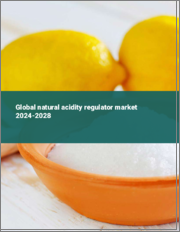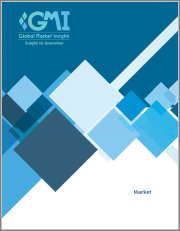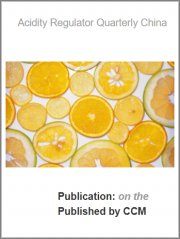
|
시장보고서
상품코드
1744618
세계의 산도 조절제 시장 : 제품 유형, 기능, 공급원, 형상, 용도, 지역별 분석, 예측(-2032년)Acidity Regulators Market Forecasts to 2032 - Global Analysis By Product Type (Organic Acids, Mineral Acids, and Other Product Types), Function, Source, Form, Application and By Geography |
||||||
Stratistics MRC에 따르면, 산도 조절제 세계 시장은 2025년에 85억 9,000만 달러, 예측 기간 동안 CAGR 9.2%로 성장하고, 2032년에는 159억 1,000만 달러에 도달할 것으로 예측됩니다.
산도 조절제는 식품 및 식품의 산도 수준을 제어하고 안정성, 안전성, 풍미 향상을 보장하는 데 사용되는 식품 첨가물입니다. 산, 염기 또는 완충제로 작용하여 음식을 보존하고 질감을 개선하며 색을 유지하는 데 도움을 줄 수 있습니다. 일반적인 산도 조절제에는 구연산, 인산, 젖산 등이 있습니다.
유럽연합(EU)에 따르면 2019년에는 15세 이상의 EU 시민의 9%가 설탕이 들어간 청량음료를 일상적으로 6%가 주에 4-6회, 19%가 주에 1-3회 섭취하고 있었습니다.
가공 식품에 대한 수요 증가
라이프 스타일의 변화와 도시화의 진전으로 가공 식품에 대한 세계 수요는 계속 증가하고 있습니다. 덧붙여 가공 식품의 제조에 불가결한 것이 되고 있습니다. 음식 식품 산업의 성장과 식품 보존의 기술 혁신이 함께, 시장의 확대를 한층 더 촉진하고 있습니다. 또한, 식품의 안전성과 품질에 대한 의식의 증가가, 제조업체에 고성능 산도 조절제의 채택을 촉진하고 있습니다.
엄격한 식품 안전 규정
세계 각국의 정부는 소비자의 안전을 보장하기 위해 산도 조절제를 포함한 식품 첨가물에 엄격한 규제를 부과하고 있습니다. 제품 제조업체에 과제를 가져와 시장 확대에 영향을 미칩니다. 또한 합성 산도 조절제와 관련된 잠재적인 건강 영향에 대한 우려로 인해 감시의 눈이 엄격해지고 있습니다.
식품 안전과 보존에 대한 요구 증가
식품의 안전성에 대한 소비자의 의식이 높아짐에 따라 효과적인 식품 보존 방법에 대한 수요가 높아지고 있습니다. 솔루션의 필요성은 점점 더 커지고 있습니다. 유기농 제품과 깨끗한 라벨 제품으로의 전환은 첨가제를 최소화하는 천연 산도 조절제에 기회를 제공합니다.
대체 저장 방법과의 충돌
고압 처리와 자연 발효 등의 대체 보존 기술은 산도 조절제에 경쟁을 가져옵니다. 이 방법은 합성 첨가물을 사용하지 않고 식품의 신선도를 유지할 수 있기 때문에 인기를 모으고 있습니다. 점점 더 선호되고 있으며, 화학적 산도 조절제에 대한 수요에 영향을 미치고 있습니다.
COVID-19의 영향
COVID-19의 대유행은 산도 조절제 시장에 다양한 영향을 주었습니다. 처음에는 공급 체인의 혼란으로 생산이 지연된 것, 식품의 안전성에 대한 관심 증가가 수요를 끌어 올렸습니다. 제품을 선호하고 산도 조절제의 사용이 증가했습니다. 팬데믹 후에는 더 건강하고 안전한 식품으로의 전환이 시장에 긍정적인 영향을 미치고 있습니다.
유기산 부문은 예측 기간 동안 최대가 될 것으로 예상
유기산 부문은 식품 보존과 풍미 강화에 널리 사용되기 때문에 예측 기간 동안 최대 시장 점유율을 차지할 것으로 예측됩니다. 유기농 재료와 클린 라벨 재료의 채용이 증가하고 있는 것이 천연 산미 조정제 수요를 더욱 밀어 올리고 있습니다.
예측 기간 동안 동물사료 분야가 가장 높은 CAGR이 예상됩니다.
예측 기간 동안 동물사료 분야가 가장 높은 성장률을 보일 것으로 예측됩니다. 효과적 사료 보존제를 사용하도록 촉구하고 있습니다.푸마르산이나 프로피온산 등의 유기산은 사료의 보존성을 높여 미생물 오염을 감소시킵니다.
최대 점유율을 차지하는 지역 :
예측기간 중 식품가공산업이 급속히 확대되고 있는 아시아태평양이 최대 시장 점유율을 차지할 것으로 예측됩니다. 식품의 안전성과 보존을 촉진하는 정부의 대처가, 산도 조절제의 채택을 더욱 뒷받침하고 있습니다.
CAGR이 가장 높은 지역 :
예측 기간 동안 북미가 가장 높은 CAGR을 나타낼 것으로 예상되는데 이는 안전하고 고품질의 식품에 대한 소비자 수요가 높아지고 있기 때문입니다. 미국과 캐나다의 엄격한 식품 안전 규정으로 인해 제조업체들은 효과적인 산도 조절제를 사용하고 있습니다. 유기 식품이나 최소한의 가공 식품에의 변화는 천연 산도 조절제에 기회를 가져오고 있습니다. 또한, 식품 보존 기술이나 원재료의 기술 혁신의 진보가 시장 확대의 원동력이 되고 있습니다.
무료 주문을 받아서 만드는 서비스 :
이 보고서를 구독하는 고객은 다음 무료 맞춤설정 옵션 중 하나를 사용할 수 있습니다.
- 기업 프로파일
- 추가 시장 기업의 종합적 프로파일링(3개사까지)
- 주요 기업의 SWOT 분석(3개사까지)
- 지역 세분화
- 고객의 관심에 응한 주요국 시장 추정, 예측 및 CAGR(주 : 타당성 확인에 따름)
- 경쟁 벤치마킹
- 제품 포트폴리오, 지리적 존재, 전략적 제휴에 기반한 주요 기업 벤치마킹
목차
제1장 주요 요약
제2장 서문
- 개요
- 이해관계자
- 조사 범위
- 조사 방법
- 데이터 마이닝
- 데이터 분석
- 데이터 검증
- 조사 접근
- 조사 자료
- 1차 조사 자료
- 2차 조사 정보원
- 전제조건
제3장 시장 동향 분석
- 성장 촉진요인
- 억제요인
- 기회
- 위협
- 제품분석
- 용도 분석
- 신흥 시장
- COVID-19의 영향
제4장 Porter's Five Forces 분석
- 공급기업의 협상력
- 구매자의 협상력
- 대체품의 위협
- 신규 참가업체의 위협
- 경쟁 기업간 경쟁 관계
제5장 세계의 산도 조절제 시장 : 제품 유형별
- 유기산
- 구연산
- 타르타르산
- 아세트산
- 푸마르산
- 젖산
- 사과산
- 미네랄산
- 인산
- 염산
- 기타 제품 유형
제6장 세계의 산도 조절제 시장 : 기능별
- pH조정제
- 항균제
- 방부제
- 풍미 증강제
제7장 세계의 산도 조절제 시장 : 공급원별
- 천연
- 합성
제8장 세계의 산도 조절제 시장 : 형태별
- 분말
- 과립
- 액체
제9장 세계의 산도 조절제 시장 : 용도별
- 식음료
- 음료
- 유제품
- 베이커리 & 과자류
- 소스, 드레싱, 조미료
- 가공식품
- 의약품
- 동물사료
- 화장품 및 퍼스널케어
- 기타 용도
제10장 세계의 산도 조절제 시장 : 지역별
- 북미
- 미국
- 캐나다
- 멕시코
- 유럽
- 독일
- 영국
- 이탈리아
- 프랑스
- 스페인
- 기타 유럽
- 아시아태평양
- 일본
- 중국
- 인도
- 호주
- 뉴질랜드
- 한국
- 기타 아시아태평양
- 남미
- 아르헨티나
- 브라질
- 칠레
- 기타 남미
- 중동 및 아프리카
- 사우디아라비아
- 아랍에미리트(UAE)
- 카타르
- 남아프리카
- 기타 중동 및 아프리카
제11장 주요 발전
- 계약, 파트너십, 협업, 합작투자
- 인수와 합병
- 신제품 발매
- 사업 확대
- 기타 주요 전략
제12장 기업 프로파일링
- Archer Daniels Midland Company(ADM)
- Cargill Incorporated
- Jungbunzlauer Suisse AG
- Tate & Lyle Plc.
- Corbion NV
- Bartek Ingredients Inc.
- FBC Industries Inc.
- Kerry Group
- Brenntag AG
- Univar Solutions Inc.
- Fuerst Day Lawson Ltd.
- Celrich Products Pvt. Ltd.
- Chemelco International BV
- ATP Group
- Foodchem International Corporation
According to Stratistics MRC, the Global Acidity Regulators Market is accounted for $8.59 billion in 2025 and is expected to reach $15.91 billion by 2032 growing at a CAGR of 9.2% during the forecast period. Acidity regulators are food additives used to control the pH level in food and beverages, ensuring stability, safety, and flavour enhancement. They can function as acids, bases, or buffering agents, helping preserve food, improve texture, and maintain colour. Common acidity regulators include citric acid, phosphoric acid, and lactic acid. These compounds are widely used in processed foods, soft drinks, and dairy products to balance taste and extend shelf life.
According to the European Union, in 2019, 9% of EU citizens aged 15 and up consumed sugar-sweetened soft drinks on a daily basis, 6% 4-6 times per week, and 19% 1-3 times per week.
Market Dynamics:
Driver:
Rising demand for processed foods
The global demand for processed foods continues to rise due to changing lifestyles and increasing urbanization. Consumers are seeking convenient and ready-to-eat food products, driving the need for effective acidity regulators. These regulators help maintain taste, texture, and shelf life, making them essential for processed food manufacturing. The growth of the food and beverage industry, coupled with innovations in food preservation, is further fuelling market expansion. Additionally, the rising awareness of food safety and quality is prompting manufacturers to adopt high-performance acidity regulators.
Restraint:
Stringent food safety regulations
Governments worldwide impose strict regulations on food additives, including acidity regulators, to ensure consumer safety. Compliance with these regulations requires extensive testing and certification, adding complexity and costs for manufacturers. Variations in regulations across different countries create challenges for international food producers, affecting market expansion. Additionally, concerns over potential health effects linked to synthetic acidity regulators have led to increased scrutiny. The regulatory landscape remains a key hurdle that companies must navigate for sustained market growth.
Opportunity:
Growing food safety and preservation needs
Rising consumer awareness about food safety is increasing the demand for effective food preservation methods. Acidity regulators play a crucial role in preventing microbial growth and spoilage, enhancing food shelf life. As food distribution channels expand globally, the need for long-lasting preservation solutions is becoming more significant. The shift toward organic and clean-label products presents opportunities for natural acidity regulators with minimal additives. Innovations in food processing technologies are also supporting the development of advanced acidity regulators with enhanced efficiency.
Threat:
Competition from alternative preservation methods
Alternative preservation techniques, such as high-pressure processing and natural fermentation, pose competition to acidity regulators. These methods are gaining popularity due to their ability to maintain food freshness without synthetic additives. Consumers are increasingly favoring preservative-free and natural food products, impacting the demand for chemical acidity regulators. Advances in biotechnology and enzyme-based food preservation offer viable substitutes that may challenge traditional acidity regulators.
Covid-19 Impact
The COVID-19 pandemic had a mixed effect on the acidity regulators market. While supply chain disruptions initially slowed production, the heightened focus on food safety boosted demand. Consumers prioritized long-lasting packaged and processed foods, leading to increased use of acidity regulators. Post-pandemic, the shift toward healthier and safer food options continues to influence the market positively. The crisis emphasized the importance of food stability and preservation, reinforcing the role of acidity regulators.
The organic acids segment is expected to be the largest during the forecast period
The organic acids segment is expected to account for the largest market share during the forecast period, due to its widespread use in food preservation and flavour enhancement. Organic acids such as citric acid, lactic acid, and acetic acid are highly preferred for their multifunctional properties. Increasing adoption of organic and clean-label ingredients is further boosting demand for natural acidity regulators. The growing preference for minimally processed food aligns with the increased use of organic acids.
The animal feed segment is expected to have the highest CAGR during the forecast period
Over the forecast period, the animal feed segment is predicted to witness the highest growth rate. Acidity regulators play a vital role in maintaining the pH balance of animal feed, improving digestion and nutrient absorption. The rising demand for high-quality meat products is encouraging farmers to use effective feed preservatives. Organic acids such as fumaric acid and propionic acid enhance feed preservation and reduce microbial contamination. The push for sustainable animal farming and reduced antibiotic use is driving greater adoption of acidity regulators.
Region with largest share:
During the forecast period, the Asia Pacific region is expected to hold the largest market share due to its rapidly expanding food processing industry. Countries such as China, India, and Japan are witnessing increased demand for packaged and ready-to-eat foods. Government initiatives promoting food safety and preservation are further supporting the adoption of acidity regulators. The rise in disposable income and changing dietary patterns are fuelling the need for food stabilization additives.
Region with highest CAGR:
Over the forecast period, the North America region is anticipated to exhibit the highest CAGR, owing to growing consumer demand for safe and high-quality food products. Stringent food safety regulations in the U.S. and Canada are prompting manufacturers to use effective acidity regulators. The shift toward organic and minimally processed foods is creating opportunities for natural acidity regulators. Additionally, advancements in food preservation technologies and ingredient innovation are driving market expansion.
Key players in the market
Some of the key players profiled in the Acidity Regulators Market include Archer Daniels Midland Company (ADM), Cargill Incorporated, Jungbunzlauer Suisse AG, Tate & Lyle Plc., Corbion N.V., Bartek Ingredients Inc., F.B.C Industries Inc., Kerry Group, Brenntag A.G., Univar Solutions Inc., Fuerst Day Lawson Ltd., Celrich Products Pvt. Ltd., Chemelco International B.V., ATP Group, and Foodchem International Corporation.
Key Developments:
In May 2025, Cargill's Bioindustrial business Partners with Arizona State University to Explore New Materials for Semiconductor Innovation Cargill Bioindustrial and Arizona State University (ASU) are launching a new, year-long research partnership focused on advanced materials used in semiconductor technology - the foundation of modern electronics from smartphones to electric vehicles.
In May 2025, Brenntag announced a sole supplier agreement with GFBiochemicals to distribute their three Levulinate esters for the CASE markets in Europe. Applications for these more sustainable and safer solvents focus on industrial solvent-based coatings, safer formulations for removing of paints as well as serving special solubility requirements for coatings.
Product Types Covered:
- Organic Acids
- Mineral Acids
- Other Product Types
Functions Covered:
- pH Control Agents
- Antimicrobial Agents
- Preservatives
- Flavor Enhancers
Sources Covered:
- Natural
- Synthetic
Forms Covered:
- Powder
- Granules
- Liquid
Applications Covered:
- Food & Beverages
- Pharmaceuticals
- Animal Feed
- Cosmetics & Personal Care
- Other Applications
Regions Covered:
- North America
- US
- Canada
- Mexico
- Europe
- Germany
- UK
- Italy
- France
- Spain
- Rest of Europe
- Asia Pacific
- Japan
- China
- India
- Australia
- New Zealand
- South Korea
- Rest of Asia Pacific
- South America
- Argentina
- Brazil
- Chile
- Rest of South America
- Middle East & Africa
- Saudi Arabia
- UAE
- Qatar
- South Africa
- Rest of Middle East & Africa
What our report offers:
- Market share assessments for the regional and country-level segments
- Strategic recommendations for the new entrants
- Covers Market data for the years 2024, 2025, 2026, 2028, and 2032
- Market Trends (Drivers, Constraints, Opportunities, Threats, Challenges, Investment Opportunities, and recommendations)
- Strategic recommendations in key business segments based on the market estimations
- Competitive landscaping mapping the key common trends
- Company profiling with detailed strategies, financials, and recent developments
- Supply chain trends mapping the latest technological advancements
Free Customization Offerings:
All the customers of this report will be entitled to receive one of the following free customization options:
- Company Profiling
- Comprehensive profiling of additional market players (up to 3)
- SWOT Analysis of key players (up to 3)
- Regional Segmentation
- Market estimations, Forecasts and CAGR of any prominent country as per the client's interest (Note: Depends on feasibility check)
- Competitive Benchmarking
- Benchmarking of key players based on product portfolio, geographical presence, and strategic alliances
Table of Contents
1 Executive Summary
2 Preface
- 2.1 Abstract
- 2.2 Stake Holders
- 2.3 Research Scope
- 2.4 Research Methodology
- 2.4.1 Data Mining
- 2.4.2 Data Analysis
- 2.4.3 Data Validation
- 2.4.4 Research Approach
- 2.5 Research Sources
- 2.5.1 Primary Research Sources
- 2.5.2 Secondary Research Sources
- 2.5.3 Assumptions
3 Market Trend Analysis
- 3.1 Introduction
- 3.2 Drivers
- 3.3 Restraints
- 3.4 Opportunities
- 3.5 Threats
- 3.6 Product Analysis
- 3.7 Application Analysis
- 3.8 Emerging Markets
- 3.9 Impact of Covid-19
4 Porters Five Force Analysis
- 4.1 Bargaining power of suppliers
- 4.2 Bargaining power of buyers
- 4.3 Threat of substitutes
- 4.4 Threat of new entrants
- 4.5 Competitive rivalry
5 Global Acidity Regulators Market, By Product Type
- 5.1 Introduction
- 5.2 Organic Acids
- 5.2.1 Citric Acid
- 5.2.2 Tartaric Acid
- 5.2.3 Acetic Acid
- 5.2.4 Fumaric Acid
- 5.2.5 Lactic Acid
- 5.2.6 Malic Acid
- 5.3 Mineral Acids
- 5.3.1 Phosphoric Acid
- 5.3.2 Hydrochloric Acid
- 5.4 Other Product Types
6 Global Acidity Regulators Market, By Function
- 6.1 Introduction
- 6.2 pH Control Agents
- 6.3 Antimicrobial Agents
- 6.4 Preservatives
- 6.5 Flavor Enhancers
7 Global Acidity Regulators Market, By Source
- 7.1 Introduction
- 7.2 Natural
- 7.3 Synthetic
8 Global Acidity Regulators Market, By Form
- 8.1 Introduction
- 8.2 Powder
- 8.3 Granules
- 8.4 Liquid
9 Global Acidity Regulators Market, By Application
- 9.1 Introduction
- 9.2 Food & Beverages
- 9.2.1 Beverages
- 9.2.2 Dairy Products
- 9.2.3 Bakery & Confectionery
- 9.2.4 Sauces, Dressings, and Condiments
- 9.2.5 Processed Food
- 9.3 Pharmaceuticals
- 9.4 Animal Feed
- 9.5 Cosmetics & Personal Care
- 9.6 Other Applications
10 Global Acidity Regulators Market, By Geography
- 10.1 Introduction
- 10.2 North America
- 10.2.1 US
- 10.2.2 Canada
- 10.2.3 Mexico
- 10.3 Europe
- 10.3.1 Germany
- 10.3.2 UK
- 10.3.3 Italy
- 10.3.4 France
- 10.3.5 Spain
- 10.3.6 Rest of Europe
- 10.4 Asia Pacific
- 10.4.1 Japan
- 10.4.2 China
- 10.4.3 India
- 10.4.4 Australia
- 10.4.5 New Zealand
- 10.4.6 South Korea
- 10.4.7 Rest of Asia Pacific
- 10.5 South America
- 10.5.1 Argentina
- 10.5.2 Brazil
- 10.5.3 Chile
- 10.5.4 Rest of South America
- 10.6 Middle East & Africa
- 10.6.1 Saudi Arabia
- 10.6.2 UAE
- 10.6.3 Qatar
- 10.6.4 South Africa
- 10.6.5 Rest of Middle East & Africa
11 Key Developments
- 11.1 Agreements, Partnerships, Collaborations and Joint Ventures
- 11.2 Acquisitions & Mergers
- 11.3 New Product Launch
- 11.4 Expansions
- 11.5 Other Key Strategies
12 Company Profiling
- 12.1 Archer Daniels Midland Company (ADM)
- 12.2 Cargill Incorporated
- 12.3 Jungbunzlauer Suisse AG
- 12.4 Tate & Lyle Plc.
- 12.5 Corbion N.V.
- 12.6 Bartek Ingredients Inc.
- 12.7 F.B.C Industries Inc.
- 12.8 Kerry Group
- 12.9 Brenntag A.G.
- 12.10 Univar Solutions Inc.
- 12.11 Fuerst Day Lawson Ltd.
- 12.12 Celrich Products Pvt. Ltd.
- 12.13 Chemelco International B.V.
- 12.14 ATP Group
- 12.15 Foodchem International Corporation














